The View from Pack: Raptor Migration 2020
You can find annual summaries of Pack Monadnock migration data from recent years here. Detailed historic data — including hourly raptor count and weather data, non-raptor observations, special notes, and season totals — are also posted on hawkcount.org, an online database managed by the Hawk Migration Association of North America (HMANA). Read on for “field reports” from the 2020 season, as shared by Hawk Watch Coordinator Phil Brown.
Highlights from the 2020 Season
Final Tally
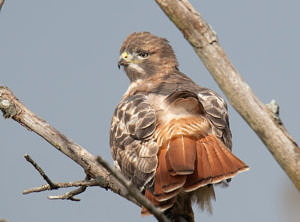
Red-tailed Hawk. (photo © Judd Nathan)
Another fine season is now in the books for the Pack Monadnock Raptor Observatory. Thanks to a moderate push of Red-tailed Hawks during the last week, we ended on November 20 with a grand total of 12,023 migrating raptors. Official counter, Levi Burford, and the hearty team of Pack volunteers worked diligently to tally birds over the course of nearly three months, finishing the fall with an impressive 557 hours of monitoring.
Despite the virus and the limitations it presented this year, the Observatory was still able to reach thousands of visitors in person in a comfortable and safe environment. Missing this year, however, were the many hundreds of students who would have interacted with Harris Center staff and volunteers, as well as those unable to travel to the Observatory to visit in person. Still, the Harris Center and NH Audubon continued to reach the masses through expanding their offerings into the virtual world. The result was reaching many hundreds of new people in this novel way of sharing information. So, some good has come out of this year. But, I think we are all looking forward to a return to in-person programming and events in 2021, including at the Observatory.
The Numbers Are In!
Below is the final count from this season, species by species, next to the 16-year mean count for that species:
| Species | 2020 Count | Mean Count |
| Turkey Vulture | 172 | 149 |
| Osprey | 162 | 233 |
| Bald Eagle | *185 | 106 |
| Northern Harrier | 108 | 86 |
| Sharp-shinned Hawk | 1,325 | 1,145 |
| Cooper’s Hawk | 180 | 146 |
| Northern Goshawk | 12 | 33 |
| Red-shouldered Hawk | *223 | 122 |
| Broad-winged Hawk | 8,815 | 8,583 |
| Red-tailed Hawk | 293 | 329 |
| Golden Eagle | 5 | 8 |
| American Kestrel | *257 | 167 |
| Merlin | 143 | 86 |
| Peregrine Falcon | 30 | 41 |
| Rough-legged Hawk | 0 | <1 |
* record high count
Non-Raptor Highlights
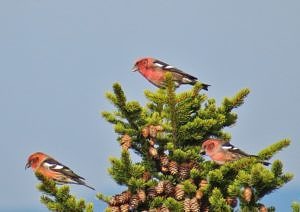
White-winged Crossbills feeding on spruce cones.
(photo © Meade Cadot)
Winter finches continued to delight right through the last day of the count on November 20. White-winged Crossbills were particularly notable as the local flock grew to nearly 100 birds and came in close, at times, to feed in the spruces.
But let’s not overlook the common birds, either! Black-capped Chickadees, Dark-eyed Juncos, and Blue Jays were constant companions and always on the lookout for raptors themselves.
Thank You
On behalf of the Harris Center and NH Audubon, I would like to extend my most sincere thanks to all who helped enable and carry out this project – from Miller State Park staff and other organizational partners to the daily volunteers who kept count to those who financially supported the project to those who visit and support the project in other ways and, finally to you, the readers of this blog. The list is far too long for this forum, but stay tuned as all of this and more will be documented in a coming Annual Report – which will be announced here at a later date and available on the Harris Center and NH Audubon websites. You can look forward to an in-depth season summary, species analyses, a complete avian species list, as well as learning about the intricacies of migration, in addition to other interesting components.
Even though many raptors have now passed us by and are largely settled into their winter homes, there is always more to learn and see by getting outdoors as often as you can, especially in such trying times. If you cannot, you can always follow the work of the Harris Center and NH Audubon to stay more connected to the world of raptors and the natural world. And if you haven’t already done so, please consider joining or supporting the work of these fantastic organizations. I look forward to sharing more with you, and, of course, follow the Observatory again here in the fall of 2021.
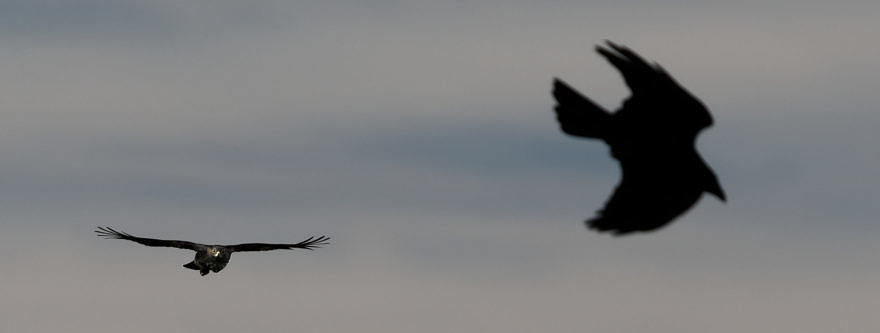
A raptor and a raven share air space above the Pack Monadnock Raptor Observatory. (photo © Andre Moraes)
Early November Update: The Home Stretch

Adult Bald Eagle. (photo © Judd Nathan)
November can be a bit of a slow time at the Observatory. Just 210 birds have been recorded migrating past the Observatory since my last report two weeks ago. This slow stretch has come with a couple of small Red-tailed Hawk pushes, and two Golden Eagles were tallied. At this point, though, barring another big flight, we are nickel and diming our way to a 12,000-migrant season by the time we call it quits on November 20. Pack last achieved this benchmark in 2016. Since Broad-winged Hawks make up such a large percentage of our tally each year (approx. 70-75%), the overall number is driven largely by this species, and it doesn’t necessarily reflect a strong year for raptors all around. The fall 2020 season has been a good year for many of our migrants, however, and on November 8 we achieved another record – again for the Red-shouldered Hawk. You may recall that back in October, a record high daily total of 70 was set for this species. That big day undoubtedly pushed the season’s overall tally to 218, passing the previous season high of 209 set back in 2012.
Bald Eagle is the next species to watch, as last season’s high count of 180 may be under siege this very weekend. (We’re already at 177.) And for the second straight season, Bald Eagle has surpassed the struggling Osprey count, which continues to slip. Golden Eagle, on the other hand, is trailing a bit behind the average season tally of seven. This year’s five is likely to increase with strong west winds on the way later this week.
Non-Raptor Highlights: Finches and Crows
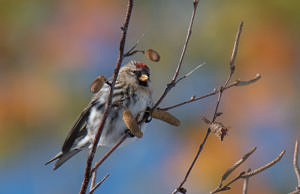
Common Redpoll – coming to a feeder near you…
(photo © Judd Nathan)
This year has been interesting for many other migrants, including the winter finches that continue to invade from the north and west. White-winged Crossbills have become a regular sight as small flocks have been seen in recent days, and Pine Siskin flocks continue to pass over the Hawk Watch. A few Common Redpolls, Pine Grosbeaks, and Red Crossbills have rounded out the irruptive northern finches.
American Crows are generally overlooked and ignored. This is perhaps because they are one of the ‘black birds’ and associated with death or other ominous signs, or possibly because they’re just so common. The beautiful Blue Jay suffers the same fate. But American Crows are a fascinating species worthy of our attention, especially when we notice large movements passing along the ridgeline in late fall. Yes, this is crow migration.
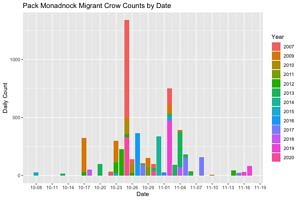
A graph of migrant American Crows by date as observed from the Pack Monadnock Raptor Observatory. Click on the image for a larger view. (graph © Levi Burford)
One cannot put migration into a small box; it is a vast and varied topic, and each migratory species – crows included – has its own unique story. Thanks to Levi’s data combing and analysis, we have been able to quantify some of this annual movement at the Observatory. We have seen that American Crow migration (different from their nightly flying into large communal roosts, which is better studied) generally peaks from late October into early November, so the big flight of 328 on October 25 wasn’t too surprising, but is always really neat to witness.
Sponsor Spotlight
As the season winds down, I’d like to extend my most sincere thanks to the Gilbert Verney Foundation. For many years, the Foundation has been a sustaining sponsor, supporting our work to keep our research and education project strong and enabling us to provide a free outdoor classroom for all who visit. Thank you for your sustaining sponsorship, and to all who continue to support the project – both first-time and repeat donors!
12,000 in Reach? The Answer is Blowing in the Wind….

A graph of Red-tailed Hawk occurrence at the Pack Monadnock Raptor Observatory over time. Click on the image for a larger view. (graph © Raptor Population Index)
Only 63 birds to hit 12,000 for the season…will we make it? The answer probably comes down to one species – the Red-tailed Hawk, the classic November migrant at Pack. This species comprises roughly half of the all-time November tally, and the 2020 tally for this species is still well below average. Both adults and the pale-tailed juveniles are now migrating south on days with a favorable ‘tail’ wind. The next couple of cold fronts will be telling. Our data have shown that Red-tailed Hawks are passing to our south in smaller numbers over the past decade, dropping at a rather alarming rate of 8.8% per year, according to the most recent Raptor Population Index analysis.
Data from other Northeast hawkwatching sites echo this trend. Red-tails have been shown to exhibit ‘short-stopping’ behavior as they become less migratory across parts of their range, perhaps due to a warming climate. This also means we’re seeing more of them wintering further north, something that Christmas Bird Count (CBC) data support. In other words, though the migration numbers are declining, it appears that the overall Red-tailed Hawk population is stable, at least for now. Read more about this phenomenon in this 2017 study in Ornithological Applications.
Planning Your Visit During the Final Week

Late afternoon sky, as viewed from the Observatory.
(photo © Phil Brown)
Even though it is not reflected accurately on their website, the Miller State Park auto road is planning to remain open through November 22, weather depending, from 9 a.m. to 4 p.m. For park information — including how to make a reservation (still a good idea for weekends!) — see the Miller State Park website. Our advice is to make a ‘Hiking Reservation,’ even if you’re planning to drive, as the road will be closed to vehicles if it’s snowy or icy.
Late Fall Raptors Have Arrived at Pack!
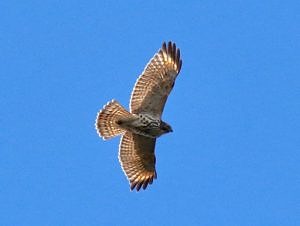
Juvenile Red-shouldered Hawk. (photo © Charlie Nims)
October continues to be a productive time at the Observatory. Late fall flights on October 22, 25, and 27 were particularly notable. Post-Broad-winged Hawk migration, hundred-bird days at the Hawk Watch become far less common, and they are generally earlier in the month of October. So two days of 150+ birds in the latter half of the month were unexpected gifts! High counts and new records for several species were tallied. An amazing 70 Red-shouldered Hawks on October 25 shattered the previous record of 46 in a day for this species. Along with 82 Sharp-shinned Hawks (a late high count), 24 Red-tailed Hawks, 22 Turkey Vultures, 12 Cooper’s Hawks, the season’s first Golden Eagle and the latest-ever record of a Broad-winged Hawk (2 birds), this 231-bird day will likely stand out in Pack history for years to come!

Actual photo of Godzilla at Pack Monadnock.
In Levi’s words on this big Red-shouldered day: “I marked down Buteos feverishly, my fingers bleeding, and by 2 p.m. (1 EST) we had tied and then blown through the record like Godzilla through Tokyo!”
An Extended Migration?
A protracted October migration has been noted in our past, and the causes may relate to weather patterns locally or regionally, late breeding birds, a changing climate, or other factors that we understand even less. But since this fall has had long stretches of favorable migration weather compared to some past seasons, the local and regional weather theory seems less likely. In looking at Sharp-shinned Hawks, there have been some commonalities to 2012 and 2015, both years in which this species has made a strong late-season push. As always, we seem to have more questions than answers when it comes to the fascinating world of raptor migration.
Other Signs of the Season

An early snow greets volunteer Mark Timmerman at the Observatory platform on October 17. (photo © Levi Burford)
The first snowfall occurred on October 17; a coating of 1.5” greeted Levi and other observers upon their arrival that morning. Other harbingers of late fall have also arrived at the Observatory. Canada Geese have begun to make a big push, with several hundred to over a thousand on a few occasions of late. American Crows, too. These common birds — known for their large communal roosts during the winter — also exhibit a pattern of seasonal movement each year, in which one or more days may see several hundred streaming past Pack low over the ridgeline. Winter finches continue and expand in diversity, the latest arrival a male Pine Grosbeak that cheerfully announced its presence yesterday afternoon. Common Redpolls and Evening Grosbeaks are starting to appear, and Pine Siskins and Red Crossbills continue, as does at least one White-winged Crossbill. From even further away (the Arctic tundra), Snow Buntings are making their first appearances.
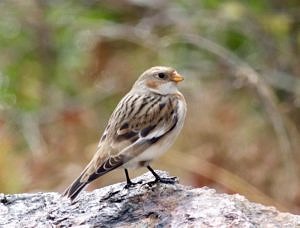
A lone Snow Bunting visits the Observatory.
(photo © Charlie Nims)
A cooperative bird spent some time on the trail near the Observatory yesterday, posing for photos before moving on in the late afternoon. I’ll take the black-and-white plumage of this Arctic visitor as a worthwhile trade for the extended foliage season we have been fortunate enough to enjoy week after week.
Thank You!
The Harris Center and NH Audubon would like to pass along special thanks to Nature’s Green Grocer (and its shoppers) for its generous support of the Pack Monadnock Raptor Observatory again in 2020. Through the store’s Green Giving Program, shoppers ‘rounded up’ their change to the tune of nearly $2,900 – a much needed and appreciated component of the project’s budget.
And if YOU haven’t yet made a contribution in support of the Observatory, there is still time. You can donate online here.
Looking Ahead into November

Employees of Nature’s Green Grocer pose with a check made out to the Harris Center. Thank you, Nature’s Green Grocer! (photo © Nature’s Green Grocer)
This Sunday marks Daylight Savings Time, that beloved day when it’s suddenly dark an hour earlier. How do we adjust our hours at the Hawk Watch, you ask? Great question! Starting Sunday, our official time for watching will be 9 a.m. to 3 p.m.; however, you may notice counters either arriving earlier or staying later, depending upon the flight. What you do need to be aware of as a driving visitor to Miller State Park is that the auto road is now in operation from 9 a.m. to 4 p.m. daily.
So, keep on coming up, dress (really) warmly, and search for more Golden Eagles, Northern Goshawks, Red-tailed Hawks, and more with us through November 20. We look forward to seeing you!
Early October Surprises and a Look Ahead

Peak foliage season has delighted thousands of Observatory visitors thus far. (photo © Meade Cadot)
The first half of October has flown by, seemingly moved along quickly by several cold fronts, which have also brought a strong push of raptors migrating past the Observatory platform. To date, our staff and volunteer counters have recorded an above-average 975 raptors during the first two weeks of the month. And although this overall number pales in comparison to the 10,000+ raptor migrants counted in September, diversity in the early part of October has expectedly ticked upward. Sharp-shinned Hawks have led the way, followed by Turkey Vultures, Cooper’s Hawks, American Kestrels, Merlins, and Bald Eagles. Only 32 Broad-winged Hawks, a species which numbered over 8,700 in September, have been counted this month. Their window as an expected species at Pack is now more or less closed as we enter the second half of October. Thus, it becomes unlikely we’ll have a ‘grand-slam’ of raptors in a single day at this point, but on one occasion (October 11), all but one species of regularly-occurring migrant raptor – the Golden Eagle – were recorded during a single day. Now is also when a greater proportion of adult raptors of many species can be noted flying by, a trend that increasingly becomes more evident in some like the Accipiters as the month goes on. This diversity in species and age is part of what keeps October hawkwatching so exciting here at Pack!
A Record-Setting ‘Big Sit’
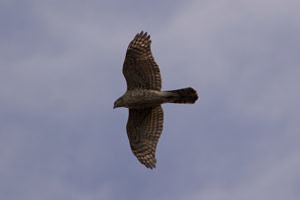
A juvenile Northern Goshawk was observed migrating during the Big Sit. (photo © Levi Burford)
With recent cold fronts and even some rain (thankfully!), many species of migrant birds have been observed passing by the Observatory. The ‘Big Sit’ on October 11 couldn’t have come on a better day for raptors and overall bird diversity, as Levi, Katrina, and others tallied a record-setting number of bird species (41) from the Pack platform area during this annual event. It was also a record-setting October day in terms of overall raptor numbers tallied with 252! Among these were daily record high counts of 123 Sharp-shinned Hawks and 17 Merlins, so truly a spectacular day. For non-raptor migrants, Canada Geese led the charge with 1,268 recorded in migrant skeins throughout the day. Double-crested Cormorant flocks were also recorded this day, and as October progresses, the window of migration opens for other waterbirds such as Scoters. One of two Boreal Chickadees continues on an almost daily basis, providing many visitors with their first look at this ‘other’ fascinating species of chickadee and visitor from the north. Songbird migration should start to slow as October wanes, and the sparrow and junco flocks will start to thin out, leaving only the hardiest of songbirds – and hawk watchers – on the mountain.
Kestrel on the Rise?
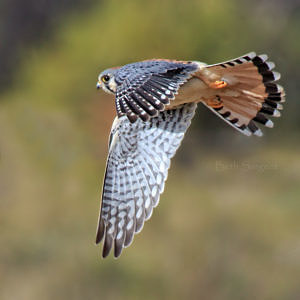
American Kestrel set a new high season count in 2020 at the Observatory. (photo © Beth Sargent)
The American Kestrel has set a new high water mark with 244 tallied thus far this season, surpassing the former high of 221 in 2010! This is a welcome sign for the declining small falcon and perhaps a sign of a partial regional recovery underway. Pack’s data – along with those of several other select hawk watches across the continent – help inform conservation biologists of population changes to raptors. According to the most recent Raptor Population Index (RPI) analysis conducted in 2020, the Observatory’s trend for this species is one that has stabilized, but nearly half of other Eastern flyway sites show a decline. More RPI trends will be released shortly, and I’ll be sure to discuss here in future Field Reports.
Looking Ahead
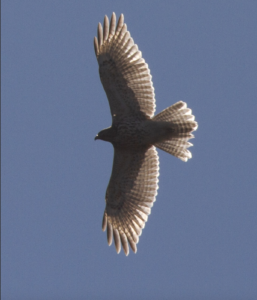
Juvenile Red-shouldered Hawk with possible bullethole in wing. (photo © Mark Timmerman)
October 14 was a sure sign of things to come for the remainder of the month as volunteer counters Mark Timmerman and Tom Delaney tallied an impressive 19 Red-shouldered Hawks winging their way south. One individual that Mark photographed appeared to have a perfectly circular hole in its wing – one we can only speculate may have been caused by a bullet. We like to think of the days of raptor shooting as being behind us, but in reality, it is still a present threat – at least in many other parts of the world. Either way, it serves as a reminder that raptors face a multitude of threats and continue to need our active protection, management, and advocacy. Now is a fine time to search for these graceful Buteos, as well as the less-common Northern Goshawk and Golden Eagle – all species which typically peak in the latter half of the month. Finally, for those searching for ‘gold,’ Levi took the initiative of preparing a graph depicting wind conditions during which this elusive raptor has been seen at the Observatory over the years. Consider this your own personal treasure map. (Thanks, Levi!) Good luck to all who search!
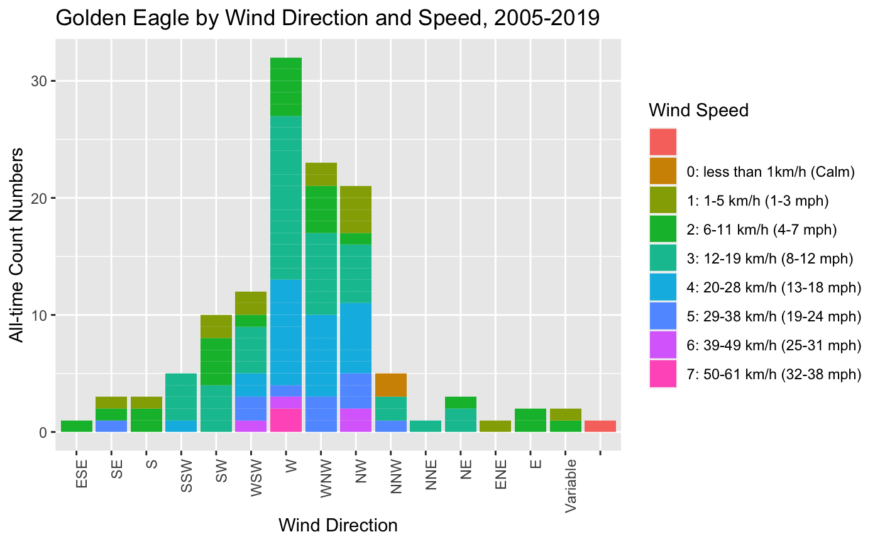
Golden Eagle occurrence by wind direction and speed. A moderate wind with a westerly component might provide a decent chance for ‘striking gold.’ (graphic © Levi Burford)
A Look Back at September and Ahead to October

Hawk watchers celebrate the 10,000th migrant raptor of the 2020 season. (photo © Cynthia Nichols)
What a month at Pack! The bulk of the Broad-winged Hawk flight came between September 11 and 20, and this species now accounts for 8,775 of the 10,090 total migrants tallied thus far. The past week has been a slow migration period, but the Observatory has welcomed many visitors hawk watching and admiring the foliage. Many eagerly await the next push of birds. Though it has already been a strong flight for several other species compared to recent years (646 Sharp-shinned Hawks, 52 Northern Harriers, and 53 Merlins), high counts for these species – and several others – are typically still ahead. American Kestrels have posted banner numbers with 184 already tallied, roughly equaling the total from the entire 2019 season. I cautiously say this could be another positive step for the kestrel, which may be showing signs of a rebound according to some migratory tallies. On the other hand, Osprey counts continue to slip (only 119 in 2020 compared to 158 and 168 in the two prior Septembers), and astoundingly low numbers of Peregrine Falcons (only 6 in 2020 vs. 43 in September of 2019) are other notable trends for this first month of the raptor migration season at the Observatory.
What’s in Store for October?
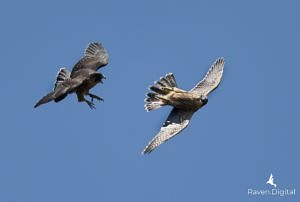
Peregrine Falcons in flight. (photo © Raven.Digital)
Thankfully, fall weather arrived again today with much needed rain and a strong cold front with west winds. This should usher in a diverse flight of migrants over the next few days, in between forecasted showers. If the conditions align, early to mid-October has potential for the rare ‘grand slam’ of raptors, when all regularly occurring migrant species are tallied in one day. Look for a final push of Broad-winged Hawks during these first few days of October – something that isn’t noted every year. Will there only be a few, or will there still be some hundreds? It’s anyone’s guess, folks! But there will be Peregrines. There simply must be. The species has been recovering steadily in its breeding range, and numbers at Pack have only grown over the years, so it’s surprising that so few have been noted in September, their peak migration month. In fact, one must go back to 2005 to find a September with lower numbers! Maybe a record high day is looming around the corner? Or could a lack of numbers mean something else – such as a delayed southbound migration due to a reliable food source up north?
Boreal Chickadee and Other Irruptive Songbirds

Boreal Chickadee at the Observatory. (photo © Phil Brown)
Some excitement greeted me upon my arrival on the platform this past Tuesday — the sound of Boreal Chickadees! These northern counterparts to our familiar Black-capped Chickadees rarely irrupt south, but when they do, we seem to notice them on the spruce-covered summit of Pack Monadnock. It is at least the fourth observatory record of this species, the last coming in November of 2018 when then-counter Chad Witko photographed and recorded one individual. Aside from ‘BoChicks’, Pine Siskins are on the move, as well as the previously reported Purple Finches, Red-breasted Nuthatches, and Red Crossbills that have been nearly daily visitors to the Observatory. White-throated Sparrows have joined the lingering junco flocks, so plenty of birds to see.
Connecting Hawk Watchers Across the Continents
Though we cannot currently cross political boundaries with ease, it’s refreshing to know that the international community of hawk watchers remains connected through the world of birds. Some fine examples of this history and spectacle will be featured in the Harris Center’s virtual programming during October, bringing both hawk watches at Hawk Mountain, PA and Veracruz, Mexico into your living rooms! For more information on these programs and others visit the Harris Center’s Events page. And stay tuned for an announcement on the Harris Center’s online calendar (or sign up for our “pop-up” event email list) to find out more about upcoming “pop-up” hawk watches at other summits.
The Human Element
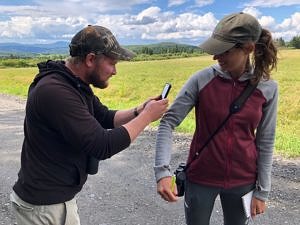
Levi and Katrina. (photo © Phil Brown)
The Observatory has a new ‘first couple’. Last week, after a big Broad-winged flight, Raptor Biologist Levi Burford presented former Raptor Biologist and current volunteer Katrina Fenton an engagement…camera lens (!) at the very spot they met three years ago. (Were you expecting a ring?) Well, Katrina accepted, and they have plans to wed! It is especially significant for me to share this news with you all as my wife Julie and I also met at the very same spot when she was the Raptor Biologist back in 2006. Who needs nightclubs and bars to meet life partners when your local hawk watch remains open? Congratulations, Katrina and Levi!!
Big Broad-winged Flights During Hawk Migration Week!
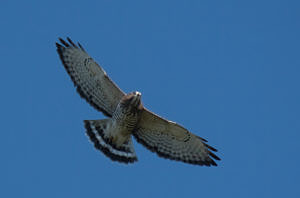
Adult Broad-winged Hawk. (photo © Judd Nathan)
International Hawk Migration Week has been an inspiring and uplifting one at the Observatory. Between September 12 and 20, an astounding 8,078 migrating raptors were tallied during this peak of the season for Broad-winged Hawks! Two of these days posted really big totals (2,269 and 3,000 birds on the September 17 and 18, respectively), and only two of the eight-day stretch had totals of less than 391. But those two days (8 and 17 total migrants) were pretty darn dead! By any measure, the past week has been among the most solid stretch for Broad-wings in the Observatory’s 16-year history.
More Broad-wings Coming?
This big push may not be over yet…historical data has shown that only once in the past 10 years has the Observatory failed to see a 1,000+ bird day between September 19 and 24. So, we’re holding out hope for one more big push, and will be eagerly awaiting what the next couple of days bring. Will the 2,000 Broad-wings tallied today at Clarry Hill in Maine make their way over our flight line? The nay-sayers will assert that since the past week’s weather has been largely favorable, this ‘river’ of birds may turn into a trickle rather quickly.
Late September
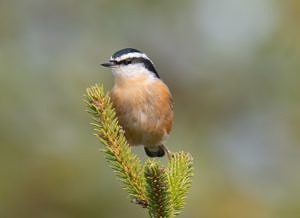
Red-breasted Nuthatch. (photo © Judd Nathan)
Regardless, there is plenty of excitement still ahead! As the peak of Broad-wings has passed, we can now begin to focus squarely on some of the other, often less-appreciated spectacles of late September into early October. The ‘Sharpie’ (or Sharp-shinned Hawk) flight, for instance, when 100 migrants can stretch across all hours of the day and all parts of the sky. The falcons, with peak counts of all three species – Kestrel, Merlin, and Peregrine – coming in the next one to two weeks. And some really big Osprey, Bald Eagle, and Northern Harrier counts, with perhaps double digits of each on some days. It’s also just an excellent time to see lots of other migrating bird species like the warblers, crossbills, and Red-breasted Nuthatches, which delight many visitors.
The Human Element
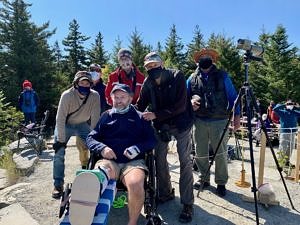
Eric Masterson surrounded by friends at the Observatory.
Yesterday was a very special day at the Observatory. Under a crisp, blue sky and surrounded by many hawk watch friends, the Harris Center’s own Eric Masterson made a glorious return to the Observatory platform. Eric suffered a terrible hanggliding crash in early August, a near-death experience that left him with a long road to full recovery – but which gave him a new lease on life. He was all smiles and in his element spotting raptors and conversing with many friends. Eric’s pursuit of birds and new ways to appreciate them continues to inspire us, and we are so glad to have him back!
Some Stats…
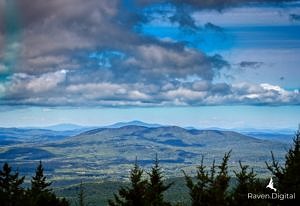
The view north from the Observatory.
(photo © Raven.Digital)
So, we like to count things at the Observatory, even things that are not birds. In fact, it’s a major part of the job and it goes beyond raptors. Levi has compiled a few numbers that show considerable decreases in two of the other major categories that we tally: Monarch butterflies, a species of conservation concern, and Homo sapiens (perhaps we should carry that same distinction?). Between September 1 and 18 of this year, observers have tallied just 462 Monarchs, compared to the 731 counted in 2019 over the same time period. We have also recorded significantly fewer total visitors to the Observatory (991 to last year’s 1,411) – but this measure is by design this year. Despite the lower numbers and lack of school groups, we have enjoyed seeing so many familiar faces at the Hawk Watch, as well as welcoming many new visitors, too.
I’ll end this report with one more statistic, one which carries a positive trend. The total number of migrating raptors past the Observatory is actually up from this same time in 2019 (8,357 in 2020, compared to last season’s 7,967.) So, take that 2019! Thanks to raptors, 2020 doesn’t suck across the board!
The Migration Floodgates Have Opened!

Hawk watchers distancing on the Pack Monadnock platform.
(photo © Phil Brown)
The first full week of the Hawk Watch was dedicated to making several necessary adjustments to maintain consistent data collection while social distancing on the observation platform.
Thanks to official counter, Levi Burford, we have new platform ‘boxes.’ This new social distancing system seems to be working out very well; thanks to all for abiding by our (and NH Parks’) required guidelines. Also, please have a mask on hand if social distancing cannot be maintained.
2020 By the Numbers (So Far)
As of yesterday, visitor numbers to the Observatory are only slightly lower than what we had seen during the pre-COVID 2019 season (522 to last year’s 629). At this point last year, we had 329 Monarch Butterflies to date. This year, as of yesterday, we’ve tallied 260 – still a strong showing compared to recent history.
As for raptors, the first ten days of the count have been relatively average (a few hundred raptors), but the migration pipeline opened up today with over 1,000 migrant raptors detected! This is on the early side for a big flight, but not unprecedented. High pressure conditions and a northwest wind should continue to usher big numbers of Broad-winged Hawks in the coming days, and we expect the biggest Broad-winged push between 9/11 and 9/24. Plan ahead and make your *reservations to enter Miller State Park soon!
*Note: this is a change from past years; reservations are encouraged and, at times, required. Visit the Miller State Park website for more information.
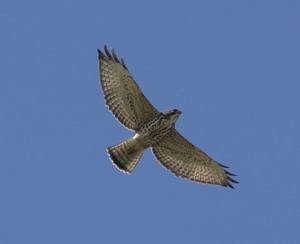
Broad-winged Hawk. (photo © Katrina Fenton)
If you’d rather avoid crowds, seek out your own vantage point at a high spot with a north-facing view. A few other good places to try in the region might include Pitcher Mountain (Stoddard), Crotched Mountain (Greenfield), or Wilson Hill (Deering). There are plenty of other places to witness Broad-winged Hawk migration, as well as all the other species, like Osprey and American Kestrel, which are starting to increase to their peaks in late September to early October. But, let’s face it – this week is really all about Broad-wingeds!
Looking Ahead to the Upcoming Week
September 17 is historically the day for Broad-winged Hawks. In fifteen consecutive years of full-coverage data, only 2005 had a count of 0 due to low clouds and only 2016 and 2018 had a count of fewer than 100 Broad-wingeds – 49 and 58 respectively. We’ll be watching the forecast for the September 17, of course, but right now it is looking like wind with a strong southern component. Tuesday, September 15, however, looks great with light to moderate NNW winds.
September 12-20 is International Hawk Migration Week (IHMW) at Pack Monadnock! We will be celebrating with a number of events including tomorrow’s ‘Big Sit’ birding event, in which the Observatory will again compete in the 2nd Annual Monadnock Region Birding Cup. Come say hi to Levi and myself, and help us find bird species of all stripes and eye ring types during this fun competition organized by the Antioch Bird Club. We at the Harris Center will also continue to bring you more virtual events than you can shake a stick at – including hawk watching programs for families, remote learners and homeschoolers; a live raptor program with NH Audubon; a celebration of IHMW with HMANA; pop-up hawk watching events at other locations (in person); and much more. For more information on all of these offerings, see our Events page.
Did You Know?
Let’s say we add up each Broad-winged Hawk observed from each season for each wind direction. In other words, we add up all observed in the SSW direction and add up all in the SW direction, etc. Guess which wind direction we have observed the most Broad-wingeds?
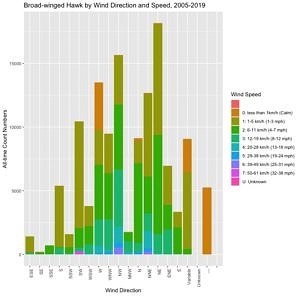
Broad-winged Hawks by Wind Direction. Click on the image for a larger view. (graphic © Levi Burford)
The answer is the Northeast. Since 2005, we have observed 18,154 Broad-winged Hawks on the NE wind. The second highest wind count is NW with 15,654 ‘wings’ observed migrating. So, a little more knowledge to help you plan your hawk watching accordingly.
Please show your support of our continuing research and efforts to connect you and so many others to the world of raptor migration! Make a contribution today by selecting “Pack Monadnock Raptor Observatory” as the program for your donation at harriscenter.org/donate.
Thanks!
The Pack Monadnock Raptor Observatory is a partnership between NH Audubon and the Harris Center for Conservation Education, hosted at Miller State Park by the NH Department of Natural and Cultural Resources, Division of Parks and Recreation.
Pack Monadnock Raptor Observatory Enters 16th Season

American Kestrel in flight (…but not in molt!)
(photo © Beth Sargent via the Flickr Creative Commons)
A ragged American Kestrel, deep in molt, was the first migrating raptor detected at the Pack Monadnock Raptor Observatory this season, as reported by official counter and Harris Center Raptor Biologist, Levi Burford. Last year, this migration research and education project of NH Audubon and the Harris Center for Conservation Education detected 185 of these small, colorful falcons (out of a total of 10,503 birds of prey tallied.)
In 2019, staff and volunteers greeted over 5,700 people, introducing many of them to raptor migration and conservation, among other themes. This year, due to COVID-19 restrictions, the Observatory will look very different. Although plenty of people are hitting the trails and safely enjoying the outdoors, there are new restrictions in place, including limitations on numbers of visitors to the Observatory platform — and to Miller State Park, our host partner. Visitors hoping to view the migration from Pack Monadnock this season should be aware that an online reservation system is now in place and that reservations are now required by all visitors to enter the park. For more information about this system, please visit the Miller State Park website.
Fortunately, the Harris Center and NH Audubon are finding new ways to connect even more people to raptors. In addition to welcoming visitors to the Observatory area (though in a very limited fashion in order to maintain social distancing), we have planned many engaging, virtual raptor-related events. You can find more information about these events here.
In addition, you can now follow the migration season online in two ways:
- Hawkcount for daily reports and next day’s predictions
- Harris Center Field Reports (this site!) for periodic migration reports, photos, and informative links
We look forward to seeing you, either in person or virtually! Stay tuned for more posts.
The Pack Monadnock Raptor Observatory is a partnership between NH Audubon and the Harris Center for Conservation Education, hosted at Miller State Park by the NH Department of Natural and Cultural Resources, Division of Parks and Recreation.
Contact Us
For more information on the Pack Monadnock Raptor Observatory or to volunteer, please contact Bird Conservation Director Phil Brown.

